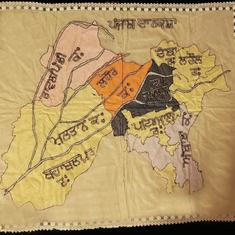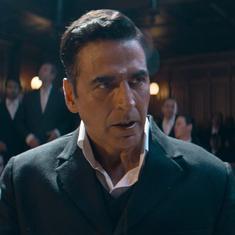To find Herod’s Gate I have to go to the other side of the Old City, to its northern wall. Beyond this wall lies the crowded commercial centre of Arab East Jerusalem, pierced by Salahdin Street with its shops, internet cafés and small hotels. The crowded pavements, where fresh kababs are roasted next to mounds of shoes and underwear, give the whole place the bustling look of an Arab market, very unlike the quiet, orderly streets of Jewish West Jerusalem. On this side lie the buildings of the American Colony and the houses of the Jerusalem notables that came up in the late nineteenth and early twentieth centuries.
It is difficult on any day, and impossible on a Friday, for a car to navigate the road that separates the Old City from this neighbourhood or to find a break in the constant stream of pedestrians, women in hijab and men in keffiyehs, many with walking canes, heading into the Old City to pray at the Al-Aqsa Mosque on the Haram, the third holiest of Muslim religious sites.
I look for flower-sellers as I enter Herod’s Gate; it has also been known as Bab al- Zahira or the Gate of Flowers down the centuries. Instead there are fruit-sellers lining its substantial archway. It is the beginning of March; the last pomegranates, the early oranges, watermelons and melons are piled up inside the gate. As I enter the archway I am greeted by a compact man of medium height, with alert, grey eyes and a polite, easy and genuine smile.
“I am Nazeer,” he says, “Nazeer Ansari.”
Quickly, he leads me through the gate and up a few steps that rise from the gate into the street inside the Old City. Before I have had time to look around, I find myself staring awestruck at a green iron gate with its two stone pillars. The words ‘Indian Hospice’ are carved on one of them and on the other, in Arabic, ‘Zawiya al- Hindiya’. An indescribable excitement grips me: an Indian presence in the middle of old Jerusalem. Nazeer smiles at my surprise and opens the gate.
“You are in India now,” he says as we start walking up the broad path from the gate. Tall saru trees with their tight pine cones line both sides of the path. “My father is waiting for you.”

I look up. At the end of that path of broad steps stands a tall, erect man, dressed elegantly in an overcoat with a woollen scarf around his neck, a soft, peaked woollen cap protecting his head.
Finally, several months after I first heard mention of this place, I am about to meet Sheikh Mohammad Munir Ansari, director of the Indian Hospice.
“You are welcome,” Sheikh Munir takes my hand warmly in both his hands. When we get to know each other better, he will always embrace me, thrice, Arab style. We stand for a few minutes at the entrance to the hospice. I try to gauge his age. He looks younger than the eighty he turns out to be. He smiles easily and the eyes behind the gold-rimmed glasses are lively. Behind us a steady stream of Palestinian women and children are coming up the path and entering a complex of two buildings that seems part of the hospice.
“Those buildings are the UNRWA clinic,” Sheikh Munir says by way of explanation in his clear, deliberate manner. “For the refugees of 1948. This building,” he points towards a part of the clinic, “was built by Indian soldiers during the Second World War. It is called the Delhi wing. And this,” he points to his left, “is where we live now: the Travancore wing. It was also built by the soldiers.”
As if on cue, the gate to the Travancore wing opens and a tall woman steps out. She is stylishly dressed in trousers and high heels and her hair is pulled back in a French knot. Confidently, she extends a hand to greet me. Her eyes shine with the same elemental playfulness that I have seen in her father’s face.
“This is my eldest daughter, Najam,” the sheikh introduces us. “And this,” he points to another smartly dressed lady who comes out of another door, “is my other daughter, Nourjahan.”
“You can call me Jani, everybody does,” she introduces herself.
“And this,” Nazeer adds, pointing to a third lady who has joined us, “is my Wafa, my dear wife.”
I don’t know it then, but this is going to be the pattern of so many meetings: Nazeer outside, his father at the top of the steps, and then the ladies in the house...

Together we enter a short narrow corridor with its chequerboard of black and white mosaic tiles. A large map of the old city of Jerusalem fills one wall.
“This is a rare map from the early twentieth century,” Nazeer points out. “On this you can see the city as it was before the takeover of 1967. You can see how close the houses were to the Wailing Wall. After ’67 they were all cleared up. And this, on the right, is our office.”
The office is a small room with a large writing desk behind which stands a large Indian flag. Iconic photos of Gandhi and Nehru adorn the walls surrounded by several small ones.
“This is my father,” Sheikh Munir points at one of them, “with Maulana Muhammad Ali of the Khilafat. And here is he alone, with a different turban, the Indian one.”
I take a quick look at the photos of the tall bespectacled Indian figure, the elder Sheikh Nazir Ansari of Saharanpur. But this, I realise, is not the time to ask about his story; there will be time enough. So we step out into the sunlit courtyard of the hospice, where the women are waiting, making idle talk around a grove of lemon and orange trees.
It’s a pleasant young sun of early March in which I enjoy the little orange that Najam hands me. I can bite right into it and eat it, peel and all. A small mosque opens out into the courtyard and, through its half-open door, I can see the bare room with its arched walls and a mihrab. A full carpet covers its floor. On the far end of the courtyard are a number of rooms, several in a state of dereliction.
Sheikh Munir points out two graves – perhaps of pilgrims or earlier sheikhs – that mark the furthest end. A visitor’s room contains more photographs, and a table with a visitor’s book with details of people who have stayed at the hospice in recent years.
Finally, I ask the question that has brought me here.
“Why is this known as Baba Farid’s hospice?”
“You are right, this is also called the ‘Zawiya al-Faridiya’. They say Baba Farid came here from India, meditated here, and then his followers began to come and stay here. A long time ago. They were given a waqf, first the mosque and those two rooms. And then the property expanded through the centuries as a place for Indian pilgrims to stay.”

Sheikh Munir leads me to one of the rooms at the far end of the courtyard. An attendant brings out a bunch of keys and unlocks a low door. I have to bend to step in. Cobwebs flutter in the sunlight that streams in and a dank smell rises from within. He points towards an opening in the floor, barely visible at the far end of the room.
“There are some rooms below this room,” Sheikh Munir says. “It is believed that those are the rooms where Baba Farid meditated. And in this room my wife and children hid when the bombs fell here in 1967 and the Israeli soldiers entered the hospice.”
It is our first meeting, so I do not push for details. But I know that I must know.
In the long drawing room in the Travancore wing, I meet the sheikh’s wife, Ikram. She speaks little but her presence is pleasing. There is tea, Indian style. “Lipton is the best,” someone says. And “bourekas”, fresh pastries stuffed with spinach and cheese, and carrot cake and poppyseed cake. Each of the women has made something and wants me to taste it.
There is even a fruit salad. “This is a French salad, in the name of Nimala, our sister who lives in Switzerland,” Nazeer explains. Someone mentions that on occasions like this they miss Nazer, the eldest brother who lives in Saudi Arabia.
They are a graceful and charming family and I hate to tear myself away. But there is much I need to know and for weeks I know I will obsess about this little Indian corner in the Old City, about the underground chamber of Baba Farid, about Indian soldiers during the World War, about shells raining down on children huddled in a dark, dank room, about the man who came here mysteriously from Saharanpur, and the family that laughs and smiles and teases one another.

Excerpted with permission from Indians at Herod’s Gate: A Jerusalem Tale, Navtej Sarna, Rupa Publications.










